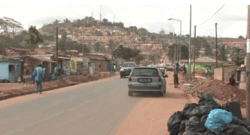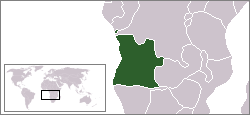Angola
Angola, a country in Central Africa, is bordered by Namibia in the south, Zambia in the east, and the Republic of Congo and the Democratic Republic of the Congo in the north. This country is rich in natural resources with large reserves of oil and diamonds, hydroelectric potential, and rich agricultural land. Despite this, Angola remains a very poor country, having been ravaged by a bloody civil war from 1975 to 2002.
- For other places with the same name, see Angola (disambiguation).
Regions
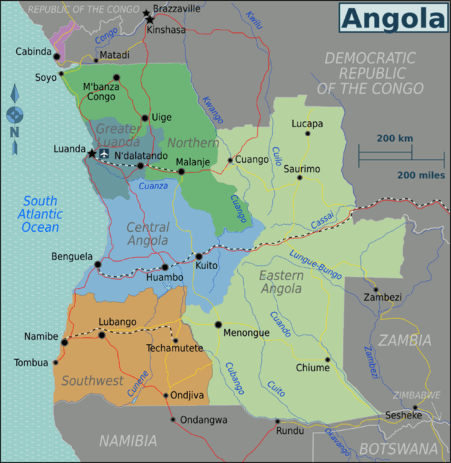
| Greater Luanda The population centre of the country and home to the capital Luanda |
| Northern Angola Northern area mostly bordering Democratic Republic of the Congo with significant areas of rainforest |
| Central Angola A series of irregular, high escarpments which drop steeply to the nation's best beaches on the Atlantic coast |
| Southwest Angola The most arid region of the country with savanna plains and the northern continuation of the Namibian desert |
| Eastern Angola The "empty" party of Angola, savannah plains intersected by five great rivers |
| Cabinda Northern exclave on the Atlantic ocean with a huge proportion of the nation's oil reserves, beautiful rainforests, and an active secessionist movement |
Cities
- 🌍 Luanda — the massive, overcrowded, chaotic, and incredibly expensive capital of the country, filled with nightlife and culture, a jarring mix of wealthy expats in the oil industry and the masses of destitute migrants from the rest of the country.
- 🌍 Benguela — the most tourist-friendly city in one of the world's least touristy countries, with a strong Carnavale tradition, pretty oceanfront, and by the nation's best beaches.
- 🌍 Cabinda — the wealthy capital of oil-rich Cabinda Province
- 🌍 Huambo — the center of the Ovimbundu region, one of Angola's larger cities that suffered greatly during the civil war, surrounded by much natural beauty.
- 🌍 Lobito — a beachfront city, basically part of Benguela, which is the epicentre of Carnavale celebrations.
- 🌍 M'banza-Kongo
- Lubango — a good base for exploring the mountainous escarpment in the center of southern Angola.
- Malanje — a destination owing to its proximity to tourist attractions like Kalandula Falls, Pungo Andongo, and Cangandala National Park.
- Menongue — a small city in the remote southeast, the terminus of the Moçâmedes Railway, from Namibe.
- Namibe — beachfront capital of the desert southwest, and jumping off point for exploring Iona National Park, and excursions to meet Khoisan peoples.
Other destinations

- Cangandala National Park — Angola's most famous park, a reserve designed to protect the critically endangered Giant Sable antelope, which is the national symbol of Angola.
- Floresta do Maiombe — a rainforest reserve in Cabinda Province with very high biodiversity and many rivers and waterfalls.
- Great Escarpment — the steepest mountains of Angola, with scenic drives (4x4 only), opportunities for adventurous hikers, and some spectacular views, most notably the Tundavala Gap.
- Iona National Park — adjacent to Namibia's Skeleton Coast, a sparsely inhabited desert region, accessible but short on infrastructure, home to some isolated and very traditional semi-nomadic peoples.
- Kalandula Falls — one of Angola's most famous sights, near Malanje.
- Kissama National Park — Angola's most accessible park, near Luanda, with accommodations for tourists.
- 🌍 Mussulo Island — a beautiful extension of land in the south of Luanda that's famous for its natural beauty; explore some of its local cuisine such as ‘pirão’, funge, and moamba.
- Pungo Andongo — large, unusual black rock formations, reasonably easy to visit from Luanda or Malanje.
- Sumbe Caves — beautiful caves in a jungle-filled canyon near the small city of Sumbe, about four hours south of Luanda.
Understand
The people of Angola are stoics. They have a deep understanding of patience, and avoid blaming the difficulties the country faces on the fact that there was war. In fact, Angolans behave as if there was no war although it is deeprooted in every Angolan. Music is the heart and soul of Angolans, it can be heard anywhere and they use anything as an excuse to party. The country has a wide range of music, mainly Kuduro, Kizomba, Semba, and Tarrachinha, the latter being more sensual than all the others. In all, it is safe to say that Angolans are fun and loving people with a thirst for more of what life has to give.
History
Prior to colonial rule, northern Angola was home to the Kingdom of Kongo, with its capital in M'banza-Kongo. The Kingdom of Kongo also had several vassal states, including the kingdoms of Ndongo and Matamba, which would unite into a powerful entity in its own right under the rule of Queen Nzinga in the 17th century.
Angola was a Portuguese colony from 1575 to 1950 and overseas territory from 1951 to 1975. After independence, Angola was the scene of an intense civil war from 1975 to 2002. The country is the second-largest petroleum and diamond producer in sub-Saharan Africa; however, its life expectancy and infant mortality rates are both among the worst ranked in the world. In August 2006, a peace treaty was signed with a faction of the FLEC, a separatist guerrilla group from the Cabinda exclave in the North, which is still active. About 65% of Angola's oil comes from that region.
Climate
Like the rest of tropical Africa, Angola experiences distinct, alternating rainy and dry seasons.
The coastal strip is tempered by the cool Benguela Current, resulting in a climate similar to coastal Peru or Baja California. It is semiarid in the South and along the coast to Luanda. There is a short rainy season lasting from February to April. Summers are hot and dry, while winters are mild. The northern part has a cool, dry season (May to October) and a hot, rainy season (November to April). In the interior, above 1,000m (3,300 ft), the temperature and rainfall decrease. The interior highlands have a mild climate with a rainy season from November through April followed by a cool dry season from May to October.
The heaviest rainfall occurs in April, and is accompanied by violent storms. The far north and Cabinda enjoy rain throughout much of the year.
Electricity
Officially 220 V, 50 Hz. Outlets are the European standard CEE-7/7 "Schukostecker" or "Schuko" or the compatible, but non-grounded, CEE-7/16 "Europlug" types. Generally speaking, U.S. and Canadian travellers should pack a transforming adapter for these outlets if they plan to use North American electrical equipment in Angola.
Also, be aware of the power related problems in Angola. If you plan to rent a house, you for sure should rent a house with a generator. Power outages are quite frequent.
Books about Angola
There is very little literature on Angola available and most of the available literature is in Portuguese or (in some cases) French.
Bay of Tigers: An Odyssey through War-torn Angola by Pedro Rosa Mendes was translated from the Portuguese and published by Harcourt in 2003. Mendes traveled across the country by train in 1997 while the war was still going on in Angola. His account is a fascinating look at the people and the nature of life there during the war.
John Frederick Walker's A Certain Curve of Horn, documents the history of a sub species of Antelope unique to Angola - "Palanca Negra Gigante" (Hippotragus níger variani).
Ryszard Kapuściński authored a journalistic narrative called Another Day of Life in which he reports on the chaotic period leading up to Angola's independence from Portugal in 1975. As one of the only journalists in Angola during this very dangerous period, his perspective is rare and full of insight.
The travel writer Paul Theroux visited Angola and wrote about it in his book The Last Train to Zona Verde (2013).
Get in
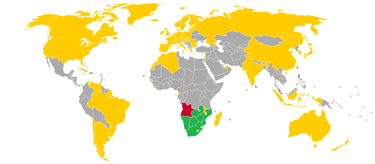
Entry requirements
Passport holders of the following countries do not need a visa to enter Angola when the purpose of the visit is tourism for up to 90 days (unless otherwise noted): Botswana, Mauritius, Mozambique, Namibia, Seychelles, Singapore, Zimbabwe.
From 30 March 2018, Angola started issuing tourist visas valid for 30 days in a simplified procedure to visitors from the following 59 countries: Algeria, Argentina, Australia, Austria, Belgium, Brazil, Bulgaria, Canada, Cape Verde, Chile, China, Croatia, Cuba, Cyprus, Czech Republic, Denmark, Estonia, Eswatini, Finland, France, Germany, Greece, Hungary, Iceland, India, Indonesia, Ireland, Israel, Italy, Japan, Republic of Korea, Latvia, Lesotho, Lithuania, Luxembourg, Madagascar, Malawi, Malta, Monaco, Morocco, Netherlands, New Zealand, Norway, Poland, Portugal, Romania, Russia, Sao Tome and Principe, Slovakia, Slovenia, Spain, Sweden, Switzerland, Timor-Leste, United Arab Emirates, United Kingdom, United States of America, Uruguay, Vatican City, Venezuela and Zambia.
Visitors must first apply for a pre-visa online with the Migration and Foreigners Service and after such pre-visa is granted they can obtain a visa on arrival at Luanda Airport. In order to obtain a pre-visa applicants must submit proof of accommodation and subsistence means, a return ticket and the international certificate of vaccination. Visa costs 120 USD, paid on arrival.
When obtaining a visa from countries to the north, you will often only be issued a 5-day transit visa for Angola. If travelling by road, this will only give you enough time to get to Luanda where it takes up to 4 days to get another five day transit visa. If you're coming into Angola from the DR Congo, you may well need an Angolan visa before entering DR Congo.
By plane
Luanda-4-de-Fevereiro is situated 4 km outside Luanda. There are public phones and bank facilities at the airport.
The most reliable taxi system from the airport is Afritaxi. Their white vehicles are clearly marked, and they charge per km or per minute, depending on how bad traffic congestion is. They only operate during daylight hours. Eco Tur also runs reliable airport transfers, but you'll need to book in advance.
TAAG Linhas Aereas de Angola has flights between Luanda and some states in Africa, for example to South Africa (Johannesburg), Namibia (Windhoek), Zimbabwe (Harare), Democratic Republic of the Congo (Kinshasa) and the Republic of Congo (Brazzaville). TAAG has two or three weekly flights to Rio de Janeiro (Brazil).
- Emirates flies directly from Dubai to Luanda and from there to more than 100 destinations worldwide.
- Ethiopian Airways flies from Addis Ababa to Luanda.
- South African Airways operates from Johannesburg to Luanda.
- Air France between Paris and Luanda
- British Airways offers direct connections between London and Luanda
- Brussels Airlines flies from Brussels to Luanda.
- Lufthansa flies from Frankfurt to Luanda.
- Sonair's Houston non-stop Express. The company is the first to provide direct transportation of passengers and cargo between Angola and the United States. The airline provides twice weekly service from Houston to Luanda.
- TAP Air Portugal flies daily from Lisbon to Luanda.
- Iberia flies from Madrid.
- Kenya Airways from Nairobi
- Air Namibia offers affordable flights between Windhoek and Luanda
By train
There are no railroad links between Angola and other nations.
By car
You can go in from Namibia at the border post near Oshikango(Namibia)/Ondjiva(Angola).
Entering from the North was, as of 2002, via Luvo, a small town on the Kinshasa-Matadi 'road'. If you want to drive through Angola, it's a real experience. Off the beaten track, road conditions might not be quite what you are used to so be prepared, particularly during the rainy season where potholes are likely to be a frequent occurrence. Also, keep a look out for livestock and the overloaded vehicles of the Angolan residents.
By bus
There are no bus links between Angola and other nations.
By boat
As of 2003, it was at least possible to enter Angola via a small passenger ferry near Rundu in Namibia. There was both an Angolan and Namibia border official present. The crossing was mostly used by Angolans for the purposes of acquiring food and other supplies in Namibia. There are (as of 2007) ferries running from the enclave of Cabinda to Luanda, which can be useful to avoid the unstable DR Congo. They carry cars as well. Seek local advice for when they depart. Sources claim that they run twice a week, cost $180 per person (bike included), and take 14 hours to do the trip (2005).
If there are no ferries, there might be cargo planes that you (and your car) can ride on between Cabinda and Luanda . Be warned - these planes are unsafe. Use them at your own peril.
Get around
By bus
There are some bus private companies which offer services as MACOM and SGO being the biggest ones. Those companies offer a wide range of services dealing with locations one wants to travel,especially inter-provincial courses. There are lines that connect most of the major cities of the country, from the coast to the interior.
By train
Angolas train system is finally being restored with the help of Chinese firms after more than 30 years of disuse. There are three main lines reflect the country's colonial past, running from the resourceful interior to the coast. They do not connect with each other.
- The northern line Caminho de Ferro de Luanda (CFL) between the capital Luanda and Malenje is back to full service. There are three classes, Primeira, with reclining leather seats with individual television sets; Exspresso, with comfortable chairs arranged in fours around tables and communal televisions; and Tramway, the cheapest option fitted out with benches to maximize passenger numbers. Ticket prices hover around 2,500 kwanzas ($26; £17). Carriges are clean and modern carriages with functioning toilets and a restaurant car. There are daily departures.
- The middle line, Caminho de Ferro de Benguela (CFB) have just started services between Lobito, Cubal and Huambo with some trains continuing to Luau at the border with Democratic Republic of Congo. There are several departures per week.
- The southern route Caminho de Ferro de Mocamedes (CFM) runs between Namibe, Lubango and Menongue.
See
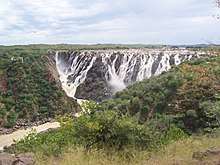
In Luanda: the Mussulo island for clean tropical beaches and water sports, the Benfica Market for Kwanza River.
Eco Tur Angola do various bespoke no tours Angola including Kissama with specialist game viewing vehicles.
In Benguela: Baia Azul for beautiful desert beaches. Art deco architecture in Benguela. Lobito City for the Restinga Peninsula and ice cold draught Cuca beer, the Benguela Rail road, and fantastic scenery.
In Kwanza Sul - Cubal Canyon, Conde Hot springs and Cachoeiras and Binga Waterfalls, with the Cambambe Dam on River Kwanza. Waku Kungo plains has fantastic scenery.
In Malange - Kalandula Waterfalls and Pungo n'Dongo Black Stones.
In Huila - Serra de Leba, Tunbda Vala Gorge, Mumuila tribespeople, fantastic scenery.
In Namibe - Arco Lagoon, beaches and a desert, and Mucubais tribespeople.
In Huambo - City Tours, Alto Hama hot springs, and fantastic scenery.
In Cunene - Himba tribes peoople, Ruacana Falls, and fantastic scenery.
Do
Talk
Portuguese is the official national language, with 70% of the population speaking it as a first or second language.
Significant native languages spoken include Umbundu, Kimbundu and Kikongo. It is also sometimes possible to use French and Afrikaans (for Namibian or South African people).
English is not widely spoken. However, as many Angolans are doing business in foreign countries, quite a few English-speaking multinational companies have offices in the country and international schools are being set up, studying English is quite popular.
Buy
Money
|
Exchange rates for Angolan kwanzas As of May 2018:
Exchange rates fluctuate. Current rates for these and other currencies are available from XE.com |
The currency of Angola is the Angolan kwanza, denoted by the symbol "Kz" (ISO code: AOA). It used to be prohibited to import or export any sum of kwanza, but now you can carry up to Kz50,000 out of the country. The kwanza (sometimes called the "new kwanza") replaced the kwanza reajustado at a rate of 1000:1 in 1995. The kwanza reajustado had replaced the novo kwanza at a rate of 1,000,000:1 in 1990. Watch out for old notes and coins.
Shopping
Just south of Luanda, the Benfica Handcrafts Market offers the best prices for handicrafts and souvenirs. This is an open market where local artists and artisans display their products, and bargaining is not only acceptable, but recommended. The products range from sculptures and paintings to jewellery, batik cloths and accessories.
Eat

Generally, dining out is not very easy in Angola, since even in Luanda restaurant food is expensive and many of the less well equipped restaurants have poor hygiene. Nonetheless, Angolan cuisine is varied and tasty, with local dishes based mainly on fish, cassava products and spicy stews.
Angolan seafood is abundant and very good, and the Angolan coast is a special place to eat fresh lobster right off the fisherman's boat.
Tropical fruit in Angola is also a treat because artisan production has maintained organic methods so that rich fruit flavours, unusual to the Western palate accustomed to industrially produced tropical fruits, predominate. If, however, you are situated in Luanda and need to dine, it is recommended that you get to Ilha de Luanda, where beach-restaurants (of varying price-classes from very exclusive to rather informal) can serve most foreign needs. It should also be said that restaurants in Luanda are increasing in numbers and quality, since the recent peace has brought stability and significant investment to the country.
Be careful: when eating out, do not drink tap water, ask for bottled mineral water instead.
Not all restaurants accept US dollars in cash; ask before ordering. Credit cards will not be accepted at most restaurants, although that is rapidly changing.
Signature and national dishes
- Doro Wat
- Muamba de galinha (Chicken Muamba)
- Mufete de cacusso - fish rubbed with fresh lemon and pepper
- Mufete - grilled fish of your choice (type of fish subject to availability) with boiled sweet potatoes and a mixture of raw finely chopped onions, peppers and tomatoes. Locals like to add beans as a side dish.
- Calulu a maneira com Funge de bombo
Drink
Sleep
World class hotels include the Tropico Hotel, the Alvalade Hotel, Le President Meridien Hotel, the Continental Hotel, the Skyna Hotel, the Epic Sana hotel, and the Palm Beach Hotel, among others.
Stay safe
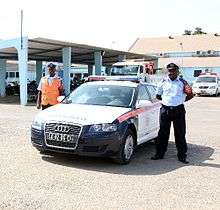
You should consider hiring a trusted and knowledgeable local guide for travel within Angola, although if you follow some basic rules then travelling in Angola isn't dangerous. Travelling after dark and alone is never a good idea. If possible, join with several cars of the same make and model because of the possible need of spare parts. Carry a satellite telephone in the case of a breakdown or other emergency. Be aware, that while Iridium satellite phones have global coverage, Thuraya satellite phones have coverage in most of Angola, but may not have coverage in the southern parts of the country (check the Angola Thuraya coverage map for details).
For the city of Luanda, other rules apply. Stay in your car (with the doors locked) while you're out of reach of security personnel, which you will find at all hotels and restaurants.
Avoid using your camera in front of police (dressed in blue uniforms). Photography will result, at best, in a very heavy fine, but could also have more dire consequences. Throughout Angola, taking photographs of sites and installations of military or security interest, including government buildings, may result in arrest or fines and should be avoided.
Angolan currency (the kwanza) may not be taken out of the country, and travelers are subject to confiscation of local currency at the airport.
Never step beyond the red and white HALO Trust posts. These denote mine fields. In fact, beware of anything surrounded by any kind of red stones or similar markers.
Stay healthy
Travelers should only drink mineral water or, in an emergency, boiled water, because water in Angola is untreated and therefore, tap water is not safe. Because malaria is endemic to this country, travelers should also avoid mosquito bites by using with insect repellent and repellent-impregnated bed nets. Furthermore, there is a risk of being bitten by the tse tse fly while in Angola, which causes sleeping sickness; consult a doctor immediately if you start having insomnia.
AIDS and HIV is prevalent among adults in Angola at 4.0% or 1 in 25 people. Avoid having unprotected sex.
Respect
If travelling to rural areas, it is important to take the time to greet the local soba (chief with government-backed authority). A few exchanged words of kindness will open doors for you to enjoy your journey in peace. Failure to inform the soba of your presence, especially if staying overnight, may have unpleasant results for your travels. Angolans are generally amiable, therefore failure to greet people who pass you by along the way may be considered rude. A simple hello will do.
Connect
The phone country code of Angola is +244. Telephone connections, cellular and landline, are heavily overloaded, making communication difficult at times. International lines are, however, often better.
